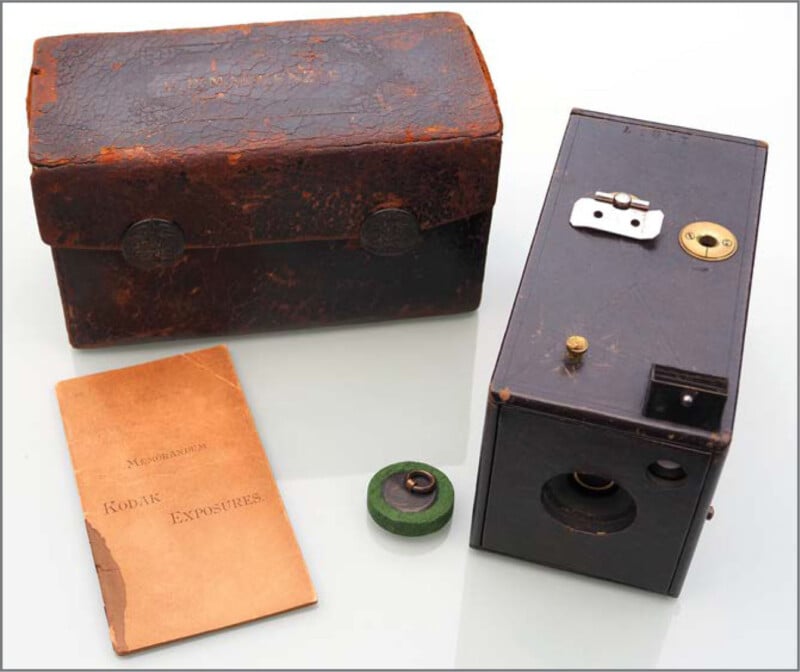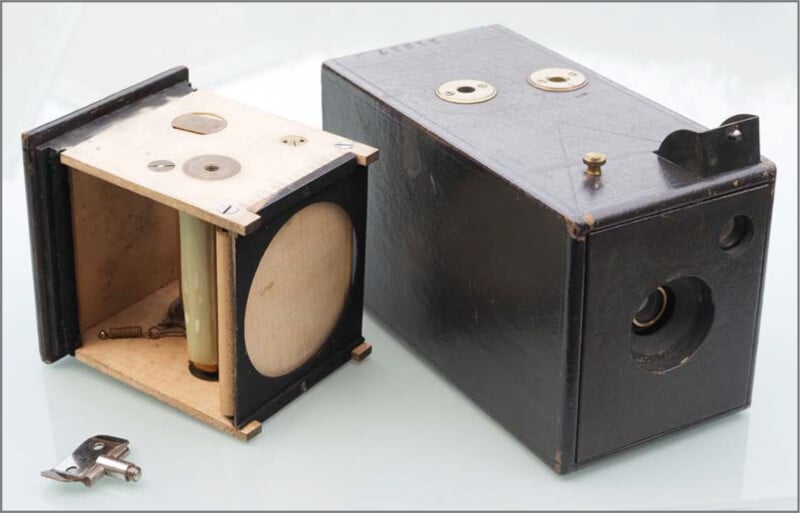
A roll of photographic film that was loaded into a camera all the way back in 1889 has been developed 134 years later revealing two mystery figures.
The Kodak rollfilm was owned by Miss Evelyn Mackenzie and shot on a No. 1 Kodak camera. Miss Mackenzie was a championship-winning golfer from Australia and an early adopter of amateur photography.
The No. 1 Kodak camera is, as the name suggests, the very first Kodak camera. It was also the first camera to successfully use negative film which was attached to a paper roll inside.
The camera came pre-loaded with a film that could take up to 100 photos. To get the photos, the camera had to be shipped back to Kodak where the film was extracted and processed. The photos were then printed and mailed back to the photographer along with the camera that contained a fresh film inside. This led to the company’s famous slogan coined by George Eastman: “You press the button, we do the rest.”

The camera came with detailed instructions on how to use it and tips on shooting with it; advising photographers that “brilliant instantaneous pictures can only be made in clear sunlight.” Adding that shooting under cloudy skies will produce no pictures at all.
Also provided were information sheets for each exposure where the budding photographers could write down the date, weather, subject, and other details. Miss Mackenzie diligently filled out the information sheets for 29 exposures.
Miss Mackenzie’s Photography in the Summer of 1889
From the information on Miss Mackenzie’s photo memorandums, she was shooting pictures of sports on bright sunny days in Melbourne and also took photos of that evergreen subject for photographers: cats.

The reason we have this information is thanks to photo enthusiast David Gardner who is a member of the Photographic Collector’s Club of Great Britain.
After Miss Mackenzie moved to England, nothing is known about the camera; until it turned up at an auction house in 2015 in England where it was purchased with Miss Mackenzie’s film still inside the camera along with her notes and inscribed case.

It was owned by one other collector before Gardner got his hands on it. After some debate, he decided to get the film developed.
However, finding someone who could develop a 134-year-old nitrate-based celluloid rollfilm was not easy; that was until Gardner discovered Film Rescue International based in Canada where it was sent to be processed. This means the camera and film have traveled to Australia, Europe, and North America — some 20,000 miles over the course of 130 years.
Greg Miller from Film Rescue International tells PetaPixel that the expert technician was wearing infrared goggles while developing the film so that he could see when the film was responding to development and pull it before it got too dense.
“With the fogging and mottling on the film, it was really difficult to tell if there was anything on it at all so the entire film was digitized using our Phase One Cultural Heritage setup,” explains Miller.
“After, we can increase the contrast and see if there’s anything to be gleaned from the film. We do have other methods of digitizing film here but the Phase One excels for this purpose because of the fact it’s 48-bit and we can use a very bright light source to burn through a lot of density as there was in this film.”

Despite the team’s expertise in film development and the 100 exposures that are possible on the film, only one negative came back with anything recognizable. Gardner felt disappointment, but Miller argues that it is still a triumph because “it is the oldest film we have ever gleaned something from” adding that it is “likely the oldest ever to be developed that had anything on it at all.”
What’s On the Film?
The recovered image shows two figures in distinct Victorian or Edwardian garb.
Gardner acquired the services of Jayne Shrimpton. a professional fashion historian, who believes that the two figures are both likely men with one of them wearing a tam o’ shanter; headwear popularized in the 1880s and remained in vogue in the early 20th century.

“The image appears to be taken, possibly from behind, of two people contemplating a piece of equipment,” writes Gardner in Photographica World; the journal of the Photographic Collector’s Club of Great Britain.
“To match Miss Mackenzie’s record, I would expect the equipment to be tennis or golf clubs, but the more I look at it the more I think it is a field camera on a tripod.”
There is no such described picture in Miss Mackenzie’s notes which has led Gardner to conclude that after shooting the 29 photographs, she removed the part of the film that had been exposed and sent it to be processed. He believes the recovered image is from the film that was left in the camera which does leave a mystery as to who exactly shot it — but it could still be Mackenzie.
But no matter who did take the grainy, barely legible picture, it still comes from a roll of film that was loaded into a No. 1 Kodak camera in 1889 — making it, in all likelihood, the oldest photo ever to be recovered from a roll of film.
